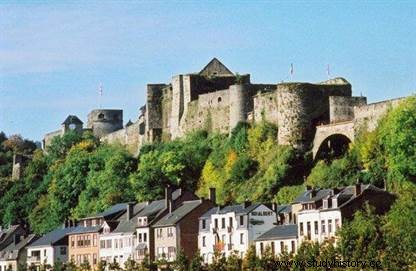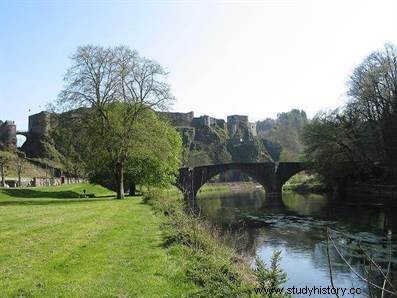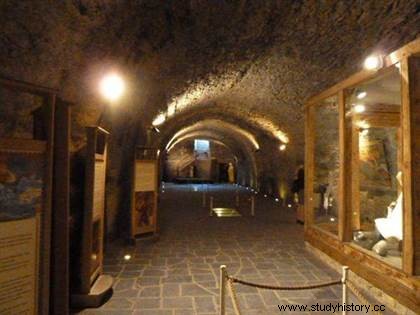 At the heart of the Semois valley stands most certainly the largest and most impressive fortress in Belgium, dominating its wide ramparts the small town of Bouillon . The latter owes its fame to its former duke, Godefroy de Bouillon, who distinguished himself during the first crusade both by playing a heroic role in the capture of Jerusalem and by refusing the title of king offered to him for the more humble lawyer of the Holy Sepulchre. As for his castle, which he sold to finance his departure for the Holy Land in 1096, it was remodeled many times, in particular by Vauban, to present itself today as a remarkable vestige of military architecture.
At the heart of the Semois valley stands most certainly the largest and most impressive fortress in Belgium, dominating its wide ramparts the small town of Bouillon . The latter owes its fame to its former duke, Godefroy de Bouillon, who distinguished himself during the first crusade both by playing a heroic role in the capture of Jerusalem and by refusing the title of king offered to him for the more humble lawyer of the Holy Sepulchre. As for his castle, which he sold to finance his departure for the Holy Land in 1096, it was remodeled many times, in particular by Vauban, to present itself today as a remarkable vestige of military architecture.
Bouillon, a strategic position in the Middle Ages...
Because of its strategic position on one of the main roads leading to Belgium, the site of Bouillon was fortified in antiquity. On the long rocky ridge dominating a wide loop of the Semois, a feudal motte very quickly rose in the 8 th century quickly becoming a real stronghold in the 11th th century. Indeed, in order to protect the small market town which had formed at the foot of the rock face, Godefroy de Bouillon had a second fortress built on the steep rock overlooking the meander of the river a few years before taking the cross.
 The castle then sold to the prince-bishops of Liège – it remained in their possession until the arrival of the French Revolution in Belgian lands – was nonetheless the object of envy and confrontation. The town of Bouillon was at the center of a small duchy generally placed under the protection and authority of the kingdom of France both in the Middle Ages and during the modern period. Although the prince-bishops of Liège owned it and claimed the ducal title, they often had to deal with the King of France, who did not hesitate to support usurpers in the event of a dispute.
The castle then sold to the prince-bishops of Liège – it remained in their possession until the arrival of the French Revolution in Belgian lands – was nonetheless the object of envy and confrontation. The town of Bouillon was at the center of a small duchy generally placed under the protection and authority of the kingdom of France both in the Middle Ages and during the modern period. Although the prince-bishops of Liège owned it and claimed the ducal title, they often had to deal with the King of France, who did not hesitate to support usurpers in the event of a dispute.
Endlessly reinforced in modern times
However, the French influence was not always present. In the XVI th century, the armies of Charles V seized and destroyed part of the castle, which was immediately rebuilt and reinforced. In 1677 during the Dutch war, the bishop of Liège having taken sides against the king of France, Louis XIV, the latter had the castle occupied militarily. Vauban took advantage of this to modernize the fortifications, notably by fitting out new entrance bastions separated by three drawbridges. He also built an arsenal and a powder magazine as well as quarters for the officers.
 Early 19th
th
century, this time it was the Dutch who took possession of the fortress and undertook new works, demolishing in the process the medieval keep that had remained until then.
Early 19th
th
century, this time it was the Dutch who took possession of the fortress and undertook new works, demolishing in the process the medieval keep that had remained until then.
Visiting the Château de Bouillon
The visit to the castle is done by following a signposted route after crossing the forts connected by bridges. Its current appearance comes largely from the various developments carried out in the 16th century. century until the Dutch period but lovers of medieval architecture will not be left out. If on one side you can admire the Vauban staircase built without cement or mortar, it is only to better access the so-called "primitive" room from the 12th th century leading us into the "Godefroy de Bouillon" room dating from the 13 th century and carved out of the rock.
Otherwise, we find all the "classics" that we imagine to be those of a castle:oubliettes, torture chamber, underground passage and of course, at the top of the tower of Austria dating from 1551, beautiful panoramas, as much of the castle as of the city or of the verdant valley of the Semois. During the summer season, a falconry show in the main courtyard is the perfect way to round off the visit.
To go further
- Visit the castle of Bouillon
